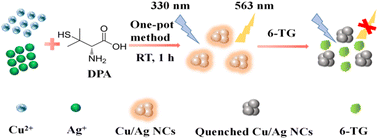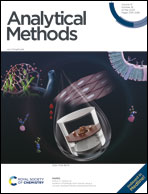A novel fluorescent nanoprobe for sensitive detection of 6-thioguanine in human serum based on Cu/Ag nanoclusters†
Abstract
6-Thioguanine (6-TG) is a purine analog anticancer drug used to treat childhood acute leukemia and inflammatory bowel disease; however, the over-dosage use of 6-TG can cause serious adverse effects. Therefore, monitoring the free 6-TG concentration in the human body is critical during drug therapy. In this work, a highly sensitive and rapid fluorescent nanoprobe based on Cu/Ag nanoclusters (NCs) for the detection of 6-TG was developed. The maximum emission wavelength of Cu/Ag NCs was observed at 563 nm with an excitation wavelength of 330 nm. A selective fluorescence quenching effect of 6-TG on the Cu/Ag NCs was found. Under optimum conditions for the determination of 6-TG, a wide linear concentration range from 2.5 to 100 μmol L−1 was observed with a limit of detection (LOD) of 1.57 μmol L−1. The characteristics of simple operation, high sensitivity and selectivity make this fluorescent nanoprobe a promising candidate for the detection of 6-TG in biological samples, as demonstrated by the application in spiked human serum with recoveries of 97.6 to 104.8%. In general, this proposed method has good potential for the detection of 6-TG in biological samples.



 Please wait while we load your content...
Please wait while we load your content...